Djahida Hadj Merabet1, Karima Bereksi Reguig2
1Department of Biology, Faculty of Natural and Life Sciences, Djillali Liabes University, Sidi Bel Abbes, Algeria
2Laboratory of Environment, Faculty of Natural and Life Sciences, Djillali Liabes University, Sidi Bel Abbes, Algeria
Correspondence to: Djahida Hadj Merabet, Department of Biology, Faculty of Natural and Life Sciences, Djillali Liabes University, Sidi Bel Abbes, Algeria.
| Email: |  |
Copyright © 2016 Scientific & Academic Publishing. All Rights Reserved.
This work is licensed under the Creative Commons Attribution International License (CC BY).
http://creativecommons.org/licenses/by/4.0/

Abstract
Background and objective: The aim of this study is to look for general and visceral obesity in the Algerian population and particularly that of the Wilaya of Sidi Bel Abbes and to compare between the two genders not only for treatment but also for prevention of such abnormality that can cause serious disturbances Patients and Methods: 772 subjects aged between 18 and 93 years old were recruited for this study including 499 women and 273 men. Our cross sectional study lasted Ten months, from April to January 2015, at the level of the Proximity Public Institutions of Health Public of the six towns in Sidi-Bel-Abbes city. Anthropometric measurement (weight, height, BMI and waist circumference) were estimated to look for general and abdominal obesity according the standards of WHO and NCEP ATP III. The statistical analysis was performed through IBM SPSS version 22. Results: The mean age in our population is 48.85±17.63 years old. Our study show that the population of the city Sidi Bel Abbes is on state of overweight with 60.70% of the population have a BMI higher than 25. We notice also that 27.9% of women are obese (BMI>30) Vs 22.5% of Men. Moreover, the study show also that the population of the six towns are overweight. We notice that the town of Ain El Berd present the highest percentage with 66.10% of the population have a BMI≥ 25 and 33.89% are obese (BMI≥30). The mean waist circumference of our population is higher only in women according the standards of NCEP ATP III. The study shows that over than 75% of women have abdominal obesity. Furthermore we notice also a highly significant difference (P<0.001) in the frequency of abdominal obesity between women and men in the sis towns of the city of Sidi Bel Abbes. Conclusion: Our study show a high prevalence of general and abdominal obesity in the northern of Algeria so we have to estimate and assess obesity in the Algerian population in order to stop it and prevent it because it can cause more serious problems.
Keywords:
Obesity, Visceral Obesity, Body mass index, Waist circumference, Sidi Bel Abbes
Cite this paper: Djahida Hadj Merabet, Karima Bereksi Reguig, Prevalence of General and Abdominal Obesity on Total Population of Western of Algeria (Province of Sidi Bel Abbes), Public Health Research, Vol. 6 No. 6, 2016, pp. 149-156. doi: 10.5923/j.phr.20160606.01.
1. Introduction
Obesity has become a health problem that is propagated worldwide. This spread is due to changes in lifestyle: diet rich in sugars, fat, poor quality proteins, lack of physical activity, and psychological disturbances.Worldwide obesity has more than doubled since 1980. In 2014, more than 1.9 billion adults, 18 years and older, were overweight. Of these over 600 million were obese. 39% of adults aged 18 years and over were overweight in 2014, and 13% were obese. Most of the world's populations live in countries where overweight and obesity kills more people than underweight. [1]General and abdominal obesity are the major subtypes of obesity. Compared with general obesity, abdominal obesity was considered to be more closely associated with chronic diabetes complications, such as cardiovascular diseases and diabetic retinopathy. [2, 3]Knowledge of the current anthropometric status of a population is important to assess its evolution and the results of any interventions [4-6].The objective of this study is to seek general and visceral obesity in the Algerian population and particularly that of the wilaya of Sidi Bel Abbes and this not only for treatment but also for prevention of such abnormality that can cause other serious metabolic disorders and this by assessing the anthropometric parameters namely body mass index and waist circumference.
2. Population and Methods
The province of Sidi Bel Abbes is a wilaya of Algeria in North Africa. It has 635 361 inhabitants in an area of 9 150.63 km2. The population density of the Sidi Bel Abbes is 69.4 inhabitants per km2. [7]Sidi Bel Abbes, Sfisef and Telagh are the biggest cities in Sidi Bel Abbès Province of the 52 towns that compose it. 772 subjects on six towns of the province were recruited for this study including 499 women and 273 men (Figure 01).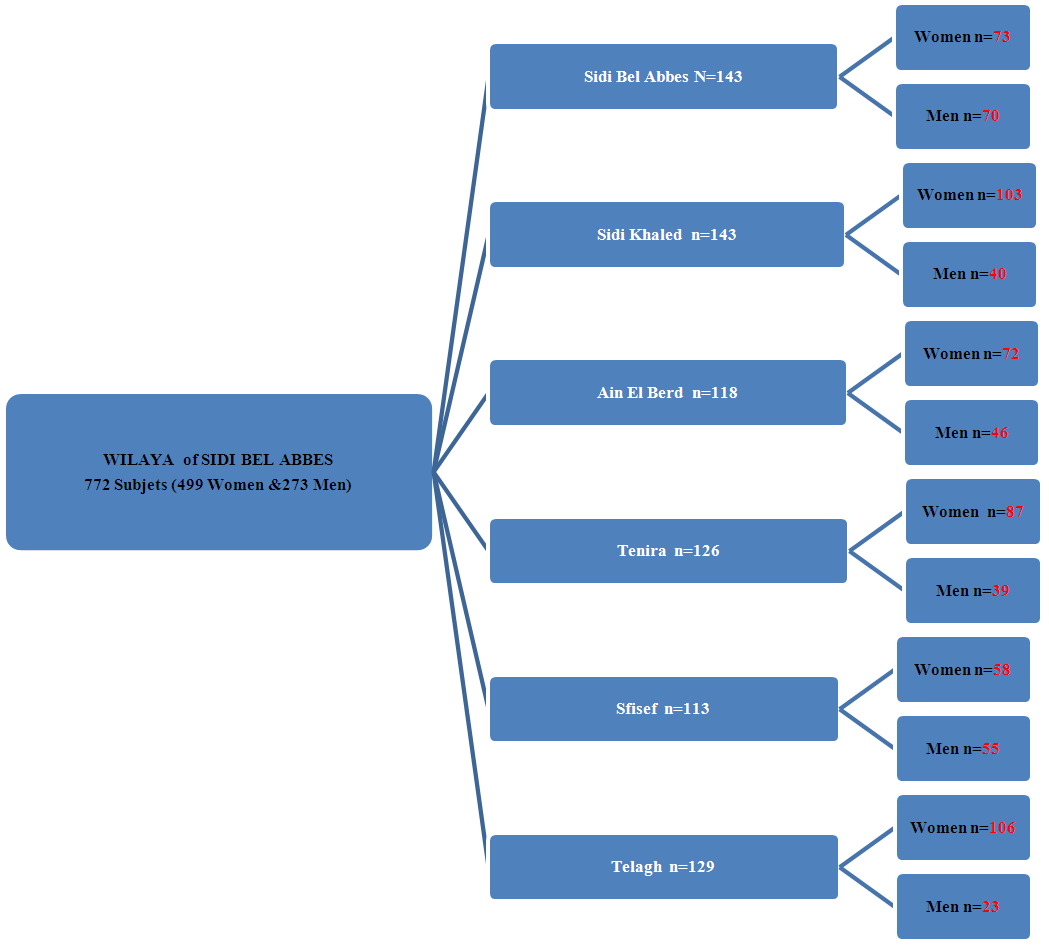 | Figure 1. Distribution of the study Population in the six towns (n=772 Subjects) |
Our subjects were people in the general population aged between 18 and 93 years old, who come for general consultation. They were asked to participate in the study after explaining the purpose of the study.Our cross sectional study lasted Ten months, from April to January 2015, at the level of the Proximity Public Institutions of Health Public of the six towns in Sidi-Bel-Abbes city.
2.1. Anthropometric Data
General obesity is defined by Body mass index and visceral obesity by waist circumference.Body mass index (BMI) and waist circumference (WC) are two criteria that have been employed for classifying obesity. Associations of obesity classified by BMI, defined as general obesity, with chronic diseases and reduced life expectancy have been well documented [8].Body Mass Index (BMI) is a simple index of weight-for-height that is commonly used to classify underweight, overweight and obesity in adults. It is defined as the weight in kilograms divided by the square of the height in metres (kg/m2). BMI= Weight (Kg)/height (m2).The classification of subjects by BMI was according the categories of world health organization international classification [9]_ Underweight (<18.5)_ Normalweight (18.5-24.99)_ Overweight (25-29.99)_ Obesity class I (moderate) (30-34.99)_ Obesity class II (severe) (35-39.99)_ Obesity class III (morbid) (≥40)Abdominal obesity was defined according the definition of NCEP ATP III.NCEP ATP III defined high waist circumference as (WC >88 cm for women and >102 cm for men) [10].
2.2. Statistical Analysis
All data are presented as means, standard deviation, median, percentiles, and percentages. Analyses were processed and performed through IBM SPSS version 22.0 [11].Significant difference is defined as p value <0.05.Furthermore, before starting the study protocol, we obtained a signed informed from all subjects, considering the ethical approval No. 299 dated 15 April 2014 from ‘the Director of Health and Population of the Wilaya of Sidi-Bel-Abbes (Algeria).
3. Results
3.1. Age
The mean age in our population is 48.85±17.63 years old (Table 1). We notice a significant difference in age between women and men in the Wilaya of Sidi Bel Abbes.Table 1. Repartition of the study Population by age in the Wilaya of sidi Bel Abbes
 |
| |
|
Our results show a significative difference of age between the two genders only in the town of Ain el Berd (Table 2).Table 2. Repartition of the study Population by age in the six Towns of Sidi Bel Abbes city
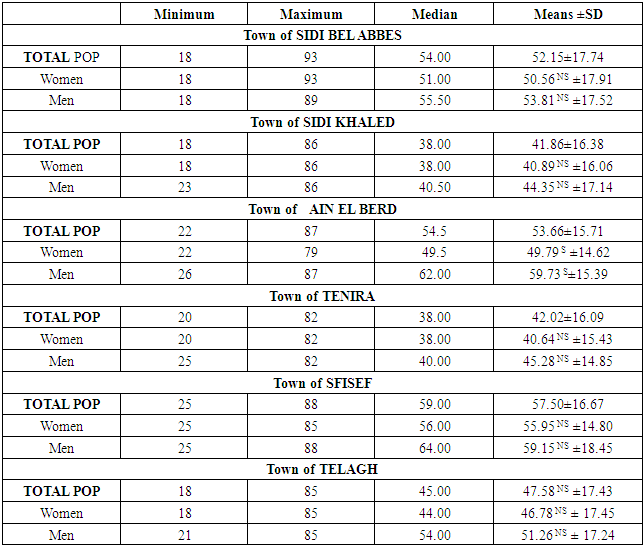 |
| |
|
3.2. Anthropometric Parameters
3.2.1. General Obesity (BMI)
The anthropometric characteristics of the whole population of the Wilaya are presented in (table 3).Table 3. Anthropometric characteristics of the whole population
 |
| |
|
We note that the population is on state of overweight (BMI>25). 60.70% of the population have a BMI higher than 25 with 34.80% are overweight and 25.90% are obese (Figure 2).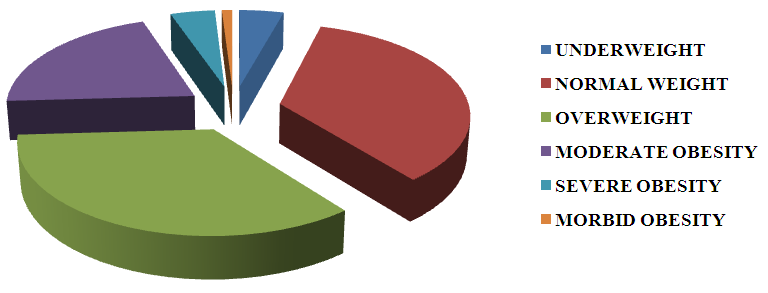 | Figure 2. BMI of the population (n=772 Subjects) |
The results show also that 20.60% present obesity class I (moderate), 4.30% obesity class II (severe) and 1% obesity class III (morbid).Comparing between the two genders, our results show that Men have higher weight and height than women in the total population of the wilaya of Sidi Bel abbes whereas women have the higher BMI.We notice a significant difference between the two genders in weight and height (Table 4).Table 4. Anthropometric characteristics of the two gender of the population
 |
| |
|
The results show also that Women and Men of our population are overweight with 58% of men present BMI higher than 25 Vs 62% of women.Moreover 27.9% of women are obese (BMI>30) Vs 22.5% of Men (Figure 3). The results show also that ideal weight is higher in men while obesity is higher in women (39.11% Vs 32.66%).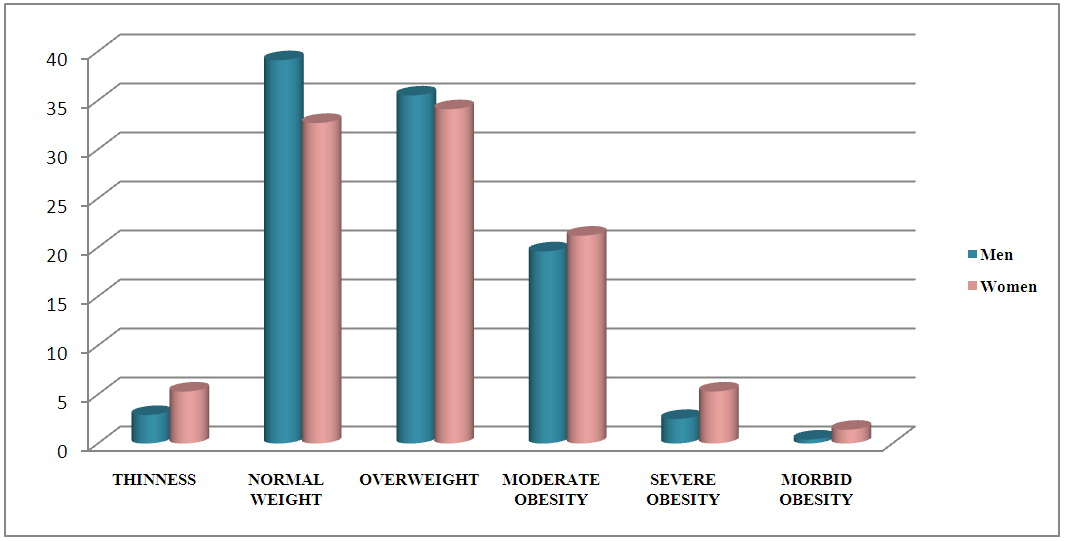 | Figure 3. BMI of the two gender of the population |
Moreover, the study show that the town of Ain El Berd present the highest percentage with 66.10% of the population have a BMI≥ 25 and 33.89% are obese (BMI≥30) (Table 5).Table 5. Overweight and Obesity in the six towns of Sidi Bel Abbes city
 |
| |
|
The study show also that the population of the six towns are overweight (Table 6); Highly significant difference were observed in the height between the two genders in the six towns.Table 6. Anthropometric characteristic of the two gender in the six towns
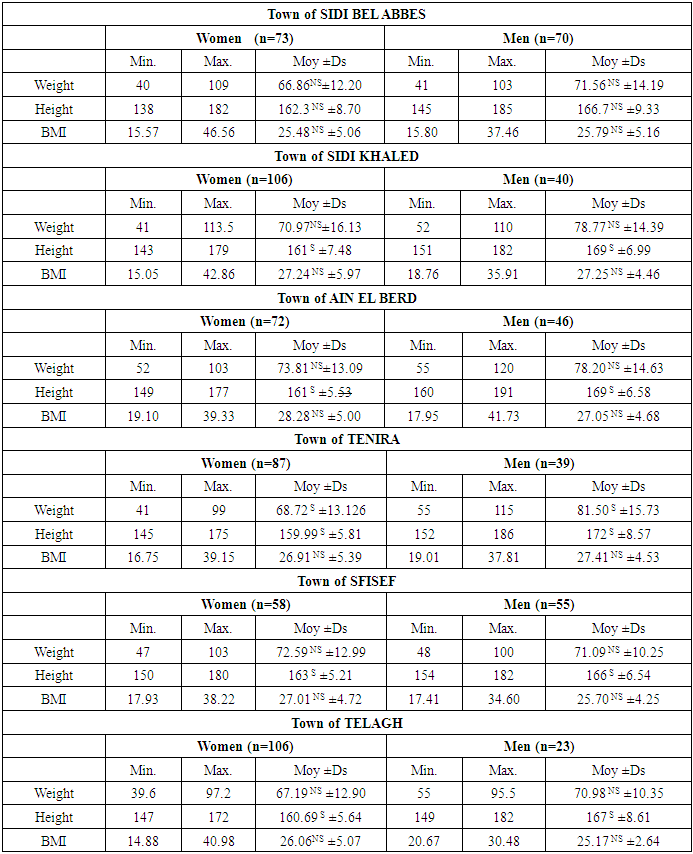 |
| |
|
Futhermore, we notice a highly signicant difference of body weight between women and men in the town of Tenira.
3.2.2. Abdominal Obesity (Waist Circumference)
The mean waist circumference is higher only in women according the standards of NCEP ATP III (Table 8).Table 7. Waist circumstance in the population of province of Sidi Bel Abbes
 |
| |
|
Table 8. WC of the two genders of the population
 |
| |
|
The study show that over than 75% of women have abdominal obesity. Moreover we notice also a highly significant difference (P<0.001) in the frequency of abdominal obesity between women and men (Table 9).Table 9. Comparison of frequency of abdominal obesity between the two gender of population
 |
| |
|
The results show also a higher significant difference in the frequency of abdominal obesity between women and men in the six towns of the city of Sidi Bel Abbes (Table 10).Table 10. Comparison of frequency of abdominal obesity between the two gender in the six towns of the city
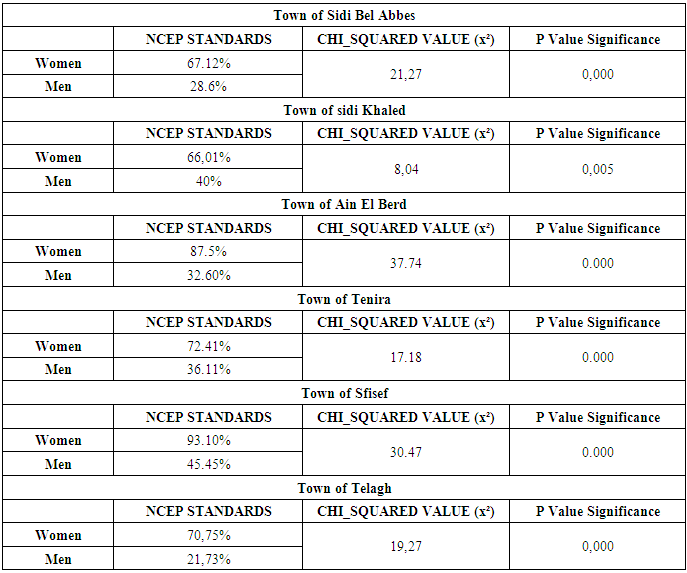 |
| |
|
4. Discussion
Obesity has become a major problem of health public in the whole world and in Algeria the situation is worrying. Our results show that the frequency and prevalence of general obesity and visceral obesity is high in our population.Obesity, the first non-infectious disease in history, is itself a priority for discussion and support [12]. Globally, obesity is now the most common metabolic disease which is subject to significant and rapid increase. In 1995, there were 200 million obese and this number rose to 315 million seven years later. [13, 14]Our population is in state of overweight with BMI = 26.66±5.06. 60.70% of the population have a BMI higher than 25; Moreover, the population of the six towns of the city of Sidi Bel Abbes is on state of overweight.The increase prevalence of overweight in Algerian population was proof by many studies.The study TAHINA ENS 2005, show that 55.90% of the Algerian population are overweight [15].Our study show that the prevalence of overweight and obesity is higher in women than men with (62% women are overweight Vs 58% men) and 27,9% of women are obese (BMI>30) Vs 22,5% of Men. This results are close to that of the study TAHINA ENS 2005, with (66.52% Women Vs 41.90% Men) are overweight and (28.39% Women Vs 8.69% Men) [15].Another descriptive cross-sectional study of a representative sample of the population of the health sector in Ain Taya (Blida) which 1511 individuals shows that 25.9% of the population is obese (32.8% women Vs 12.2% men) [16].The study show a highly significant difference (P<0.001) in the frequency of abdominal obesity between women and men (Table 9). Over than 75% of women have abdominal obesity Vs 34.43% men. This difference was notice in the six towns of the city. The same studies show also a highly difference in the prevalence of abdominal obesity between the two gender; TAHINA ENS 2005 with 75.02% women Vs 35.43% men [15], and the study of chibane and al with 68,8 women Vs 23,2% men [16].
5. Conclusions
Our study show that the prevalence of overweight, obesity and abdominal obesity is high in the northern of Algeria and the difference between the two genders is very significant.We have to estimate and assess obesity in the Algerian population in order to stop it and prevent it because it can cause more serious problems.
Abbreviation
NCEP ATP III: National Cholesterol Program Adult Treatment Panel IIIWC: Waist CircumferenceSD: Standard DeviationS: Significantly different at p<0,05NS: Not Significantly different
ACKNOWLEDGEMENTS
A big thank to the director and all the staff of Health and Population of the wilaya of Sidi Bel Abbes and also the directors and staff of Public Institutions of Health Public of the six towns in Sidi-Bel-Abbes city.
References
| [1] | WHO Fact Sheet No: 311 (2015). Overweight and Obesity. Updated January 2015. |
| [2] | Balkau B, Dean field JE, Despres JP, et al. International Day for the Evaluation of Abdominal Obesity (IDEA): a study of waist circumference, cardiovascular disease, and diabetes mellitus in 168,000 primary care patients in 63 countries. Circulation 2007; 116: 1942–1951. |
| [3] | Man RE, Sabanayagam C, Chiang PP, et al. Differential association of generalized and abdominal obesity with diabetic retinopathy in Asian patients with type 2 diabetes. JAMA Ophthalmol 2016; 134: 251 257. |
| [4] | Ministry of Health, Consumer Affairs, and Gender and Social Services, Encuesta Nacional de Salud 2011-2012, Ministerio de Sanidad, Consumo, Igualdad y Servicios Sociales, Madrid, Spain, 2013. |
| [5] | R. M. Ortega Anta, A. M. López-Sobaler, and N. Pérez-Farinós, “Associated factors of obesity in Spanish representative samples,” Nutricion Hospitalaria, vol. 28, no. 5, pp. 56–62, 2013. View at Publisher · View at Google Scholar · View at Scopus. |
| [6] | N. Pérez-Farinós, A. M. López-Sobaler, M. Á. Dal Re et al., “The ALADINO study: a national study of prevalence of overweight and obesity in spanish children in 2011,” BioMed Research International, vol. 2013, Article ID 163687, 7 pages, 2013. View at Publisher · View at Google Scholar · View at Scopus. |
| [7] | Direction of Health and Population - SIDI BEL ABBES Mars 2015. |
| [8] | Ogden CL, Yanovski SZ, Carroll MD, Flegal KM: The epidemiology of obesity. Gastroenterology. 2007, 132: 2087-2012. 10.1053/j.gastro.2007.03.052. |
| [9] | World Health Organization, “Obesity: preventing and managing the global epidemic: report of a WHO consultation,” WHO Technical Report Series 894, World Health Organization, Geneva, Switzerland, 2000. View at Google Scholar. |
| [10] | National Cholesterol Education Program (NCEP) Expert Panel on Detection, Evaluation, and Treatment of High Blood Cholesterol in Adults (Adult Treatment Panel III). Third Report of the National Cholesterol Education Program (NCEP) Expert Panel on Detection, Evaluation, and Treatment of High Blood Cholesterol in Adults (Adult Treatment Panel III) final report. Circulation. 2002; 106: 3143–3421. |
| [11] | IBM Corp. Released 2013. IBM SPSS Statistics for Windows, Version 22.0. Armonk, NY: IBM Corp. |
| [12] | Janquero D, Rival Y. Syndrome Métabolique: Quel (s) définition pour quelle (s) traitement: Laboratoires Pierre Fabre, 17, avenue Jean Moulin, 81100 Castres, France 2005. |
| [13] | Caterson ID, Gill TP. Obesity: Epidemiology and possible prevention. Best Pract Res Clin Endocrinol Metab 2002; 16: 595-610. |
| [14] | Formiguera X, Canton A. Obesity: Epidemiology and clinical aspects. Best Pract nd Res Clin Gastroenterol 2004; 18, 1125-46. |
| [15] | Enquête Nationale Santé 2005 Institut National de Santé Publique 4, chemin El Bakr, El Biar, Alger. Tel: 213. (21). 91.20.23./24 Fax: 213. (21). 91.27.37 Transition épidémiologique et système de santé Projet TAHINA (Contrat n° ICA3-CT-2002-10011). |
| [16] | Chibane M , Attif L, Makhlouf L, Lanasri N and Biad A. Prévalence de l’obésité dans un secteur sanitaire de l’Algérois. Diabetes & Metabolism; Volume 34, Supplement 3, March 2008, Pages H74-H75. |






 Abstract
Abstract Reference
Reference Full-Text PDF
Full-Text PDF Full-text HTML
Full-text HTML








